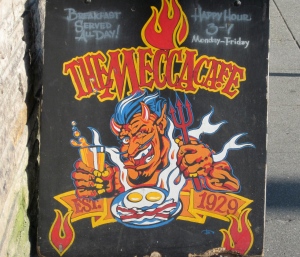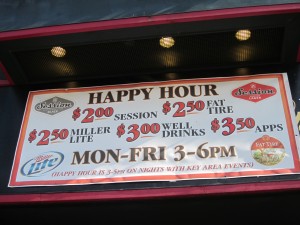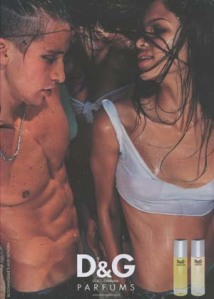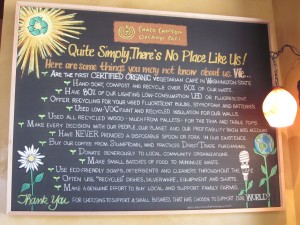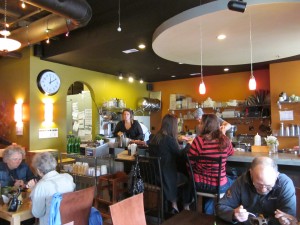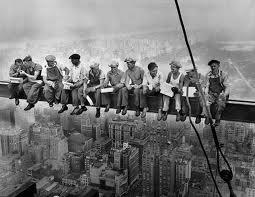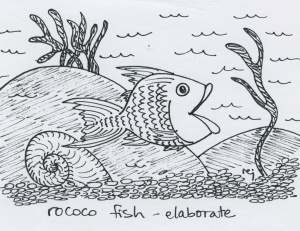One could hardly find two more different museums that the Henry and the Burke. Where one is for a select crowd, the other strives for inclusion of all…. where one is obscure in its mapping, the other is straightforward and clear…. where one uses mostly sans serif font, the other uses serif…. where one is sparse in decor and density, the other is stuffed with information and displays…. where one is a fine art gallery, the other is an interactive museum…

Henry Art Gallery entrance

Burke Museum entrance
I think each is relevant to its respective target audience, and that answering the questions below does indeed make a difference to the design.
1. How well does the design address the varied demographics that use the museum? Who goes here?
2. What assumptions do you have about the work in the museum and the nature of the museum itself?
…and as such…. how these museums address font, typography, lighting, density of displays, and layout are connected to the above answers.
For the Henry…
My impression is that it’s designed for people over 18 years of age with a higher education. The focus is on the art pieces themselves, and less so on the information about them. I found the explanations, such as the introduction to the Talent Show, easy to walk by (without noticing them). I found myself backtracking though, and looking for the explanation of the display because I didn’t get it on first glance, due to the varied artists, themes and media.
The density of display is low so that the depths of the ideas behind the works have more room to move around the space. The hallways are also bare. I think it’s because the target audience wants to think for themselves, and not be bombarded with a bunch of clutter, leaving more room for open interpretation. Color, along with this, is simple and limited to greys and wood tones.

Henry low-density display
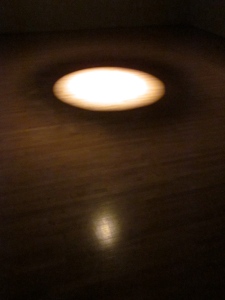
David Lamelas's spotlight - simple yet deep

- Henry bare hallway
James Turrell’s Light Reign is the epitome of the Henry – simple, elegant, using the natural to create art, and with minimal words…

Light Reign
There was one exhibit entitled “Inspiring Vision: Looking at Photography” that contradicted the message it was trying to get across, with mere placement. In its explanation, it said, “everyday looking is fast-paced, but looking at art takes time – deep looking to achieve awareness and understanding requires thoughtful reflection.” It was staged in a hallway with an echo and traffic flow, hardly conducive to reflection or pause.
The wayfinding was minimal, probably because the they think the target audience doesn’t need much guidance, and will find their way around.

Lighting is focused on the works themselves with spot lights or track lighting, and the remainder is either natural lighting or darkness. Minimalist and simple. The font lines up with the themes of simplicity and sparseness, with its sans serif motifs.

Font at the Henry
To add to the exclusive feel, there seem to be a lot of closed doors, only accessible to staff.

staff only
All in hall, the Henry Art Gallery is cohesive in its intellectual, higher-end, modern (I mean that :o)), exclusive feel. The website isn’t however… it is cluttered and uses serif font, which makes for a different vibe from the gallery itself.
For the Burke…
The Burke seems to be aimed at all ages with its varied kinds of displays and information presentation within those displays. It is especially geared towards families with kids, or schools. The educational component is high, so the density of information is also high. As compared to the Henry’s one newspaper available at the entrance, the number and variety of handouts at the front kiosk exemplifies that they are working to reach many audiences, with a handout for each.
Upon entering, one gets a more welcoming sense than the Henry, along with a little kid humor:

Burke welcomes dinosaurs!
Part of the welcoming feeling comes from the serif font, and part comes from the lighting that is more orange in tone, kind of homey. The labeling and way-finding is more explicit – making it such that a kid could find her way around. It is also of multiple textures and levels, from the waist-level tables up to the ceiling with stuffed birds. It’s an all-encompassing full-body experience. There is visual stimulation, sounds, stuffed animals to touch, buttons to push, magnetic poetry, and puzzles. I guess the only sense missing was smell – maybe that’s a good thing. Along with this, I could be wrong, but I remember the lighting being more general than the Henry, because there was so much to look around for.

stuffed education to play with
The introduction in the Owl photography exhibit is central, right in front of you as you come in, can’t miss it. This supports the idea of obvious way-finding and explicit directions. The remainder of the information is presented in small chunks, for the short attention spans of their target audience.
The Biodiversity exhibit is also multi-textured and multi-use.With a variety of paintings, 3D sculptures, books, rocks with flashcards, a periscope and sounds.
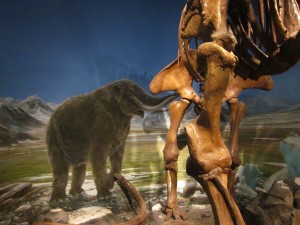
multi-textured displays
The graphics used lots of colors, for the intended audience. They got a little carried away with the c0lor-coding of the display graphics, however, which detracted from the information. Each of these “Where’s Washington” signs came color-coded with it’s theme, and the theme in turn used that color font in their titles, but it was too subtle and too varied to make for useful coding.

this sign came in green, blue, red, orange...

green title goes with green "Where's Washington" sign, and so on...
One poor example of the coloring in the signage came not with the color-coding, but in the sign itself, because of the values of the font vs the background.

confusing value
The stairways were full of art, always something for the audience to look at…
And downstairs, the Pacific Voices, that was displaying a variety of populations, just like the Talent Show, chose to represent it with many colors and varying font. Note the contrast in the titles of these exhibits, although they are each aiming at expressing many people’s voices…

colorful "Voices" of the Burke

monochromatic & uniform "Talent Show" of the Henry
As a side note, both flows of the exhibits were to the right of the title. Reiterating the difference in way-finding, the Talent Show explanation was on a wall to the left of the title, out of the natural flow of one’s experience. Note in the picture above, of the Voices, how the explanation is to the right, and part of the flow.
The exhibits within the Voices were elaborate, and with brief explanations.

Japan display
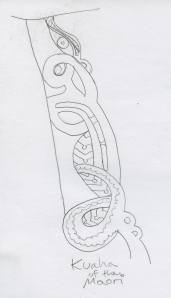
Kuaha of the Maori, on display
As a conclusion for the Burke, it too was cohesive in its “feel” for its intended audience, and while some of the graphics weren’t brilliant, it was nonetheless full of user-friendly information and guidance, aimed at a complex audience of a broad age-range and varied demographics. The website was consistent with it’s dense and informative material and diversity.



